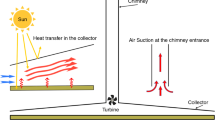Abstract
Solar energy is one of the most feasible options to produce energy in countries where unexploited desert areas or solar radiation are abundant. An energy tower is an effective system for electrical power generation that can perform more efficiently along with solar radiation. As the primary aim of the present study, effects of different environmental parameters on total efficacy of energy tower were investigated. In this study, the efficiency of the energy tower system is investigated experimentally by an indoor fully adjustable apparatus. In this regard, a comprehensive set of influencing parameters like air velocity, humidity, and temperature and the effects of tower height on the performance of the energy tower are individually assessed. It is demonstrated that there is a direct relationship between an increase in humidity percentage of the surrounding and performance of energy tower, meaning that a 274% increase in humidification rate led to 43% elevation in airflow velocity. The kinetic energy increases in the direction of airflow from top to bottom, and as the height of the tower lengthens, the kinetic energy enhances and subsequently increases the overall efficiency of the tower. An elevation about 2.7% in airflow velocity was seen due to an increase from 180 to 250 cm in chimney height. Although the energy tower performs efficiently in the nighttime, airflow velocity increases averagely about 8% during the daytime and at the peak of the solar radiation, the airflow velocity enhances by 58% compared to nighttime.







Similar content being viewed by others
Data availability
Data that support the findings of this research will be reposited by inquiry.
References
Altman T, Dan Z, Guetta R, Gregor C (2005a) Evaluation of the potential of electricity and desalinated water supply by using technology of energy towers. For Australia and America, Interim Report
Altmann T, Carmel Y, Guetta R, Zaslavsky D, Doytsher Y (2005b) Assessment of an energy tower potential in Australia using a mathematical model and GIS. Sol Energy 78(6):799–808
Assaf G, and Lucien B (1989) Method of and means for generating electricity in an arid environment using elongated open or enclosed ducts. Google Patents
Carlson PR (1975) Power generation through controlled convection (aeroelectric power generation), Google Patents
Golzardi S, Mehdipour R, Baniamerian Z (2021) How collector entrance influences the solar chimney performance: experimental assessment. J Therm Anal Calorim 146(1):813–826
Haaf W (1984) Solar chimneys: Part Ii: preliminary test results from the Manzanares pilot plant. Int J Sustainable Energy 2(2):141–61
Haaf W, Friedrich K, Mayr G, Schlaich J (1983) Solar chimneys Part I: principle and construction of the pilot plant in Manzanares. Int J Solar Energy 2(1):3–20
Hoseini H, Mehdipour R (2018) Evaluation of solar-chimney power plants with multiple-angle collectors. J Comput Appl Res Mech Eng (JCARME) 8(1):85–96
Hoseini H, Mehdipour R (2020) Performance evaluation of hybrid solar chimneys for fresh water production. Environ Prog Sustain Energy 39(1):13276
Kasaeian A, Ghalamchi M, Ghalamchi M (2014) Simulation and optimization of geometric parameters of a solar chimney in Tehran. Energy Convers Manage 83:28–34
Lucier RE (1979) Apparatus for converting solar to electrical energy. US. Patent
Mehdipour R, Golzardi S, Baniamerian Z (2020a) Experimental justification of poor thermal and flow performance of solar chimney by an innovative indoor experimental setup. Renewable Energy 157:1089–1101
Mehdipour R, Baniamerian Z, Golzardi S, Murshed SM (2020b) Geometry modification of solar collector to improve performance of solar chimneys. Renewable Energy 162:160–170
Mehdipour R, Ghaffari A (2021) Solar dryer performance simulation: experimental and numerical study. J Food Process Eng 44(11):1–18
Mehdipour R, Mohammadi E, Babaie Parsa AM, Nahalekah H (2021) Thermal and exergy assessment of solar chimney performance in various energy absorptions; using indoor experimental setup. Heat Mass Transf 57(3):417–429
Mezhibovski V (1999) Numerical simulation of the flow in energy towers and their surroundings. Agricultural Engineering. MSc Thesis, Submitted to The Technion--Israel Institute of Technology, Haifa. In Hebrew
Omer E, Guetta R, Ioslovich I, Gutman PO, Borshchevsky M (2008) Optimal design of an energy tower power plant. IEEE Trans Energy Convers 23(1):215–225
Pearlmutter D, Evyatar E, Etzion Y (2008) A multi-stage down-draft evaporative cool tower for semi-enclosed spaces: experiments with a water spraying system. Sol Energy 82(5):430–440
Schlaich J (1995) The solar chimney: electricity from the sun. Edition Axel Menges
Zaslavsky D (1999) Energy towers for producing electricity and desalinated water without a collector. Technion Israel Inst Technol Haifa Israel Internal Rep
Zaslavsky D, Guetta R, Hitron R, Krivchenko G, Burt M, and Michael P (2003) Renewable resource hydro/aero-power generation plant and method of generating hydro/aero-power. Google Patents
Zwin MJ (1997) Energy towers pros and cons of the Arubot Sharav alternative energy proposal. Arava Institute for Environmental Studies, Kibbutz Ketura, Israel
Author information
Authors and Affiliations
Contributions
Conceptualization: Ramin Mehdipour, Zahra Baniamerian; methodology: Ramin Mehdipour; formal analysis: Ramin Mehdipour, Mojtaba Habibi, Mohammad Eydiyan, and Ehsan Mohammadi; writing — original draft preparation: Ramin Mehdipour and Ehsan Mohammadi; writing — review and editing: Ramin Mehdipour, Ehsan Mohammadi, and Zahra Baniamerian; funding acquisition: Ramin Mehdipour; resources: Ramin Mehdipour; supervision: Ramin Mehdipour.
Corresponding author
Ethics declarations
Ethical approval
The present research does not involve human participants and/or animals.
Consent to participate
The authors consent to participate and publish.
Consent to publish
The authors consent to publish the results.
Competing interests
The authors declare no competing interests.
Additional information
Responsible Editor: Philippe Garrigues
Publisher's note
Springer Nature remains neutral with regard to jurisdictional claims in published maps and institutional affiliations.
Rights and permissions
Springer Nature or its licensor (e.g. a society or other partner) holds exclusive rights to this article under a publishing agreement with the author(s) or other rightsholder(s); author self-archiving of the accepted manuscript version of this article is solely governed by the terms of such publishing agreement and applicable law.
About this article
Cite this article
Mehdipour, R., Habibi, M., Eydiyan, M. et al. Experimental assessment of energy tower’s performance: evaluation of the impacts of solar radiation, humidity, and chimney’s height on the overall efficiency. Environ Sci Pollut Res 31, 18200–18208 (2024). https://doi.org/10.1007/s11356-023-26401-x
Received:
Accepted:
Published:
Issue Date:
DOI: https://doi.org/10.1007/s11356-023-26401-x




